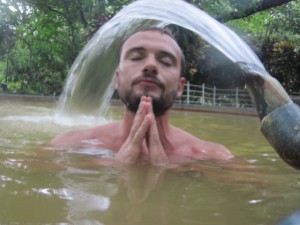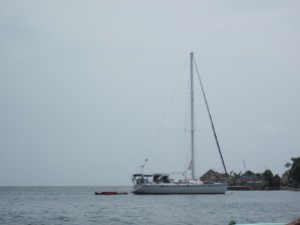
Singlehanding my way back: from Panama to the US
As usual departing was laborious. Breaking the inertia was necessary to abandon Panama, a place that ended up feeling like a trap. Maybe I am just not that good with change anymore, and everything seem like a struggle. Or maybe I hit a dark spot while drifting about on the Atlantic coast of Panama and dealing with its fascinating cultures.
Sort of Heart of Darkness feeling, if you know what I mean.
Eventually, I found myself alone with Beta on Tranquility pointing North under full sail. I left Linton Bay in the early afternoon of the 28th of November. Hurricane season seemed to had finally cooled off, and the strong trade winds had not arrived yet.
It was the first time I sailed singlehanded in a long passage. I felt both excited and worried. My mind was more concerned about discomfort than personal safety. I trusted my boat. I couldn’t say the same about myself.

Final destination was Brunswick in Georgia and, another first time for me, I had a schedule. I had booked a flight to Italy leaving from Jacksonville on Christmas Eve. There was enough time to make it… if everything went well.
Set on a close reach, I let the boat going more or less the direction I wanted. I forgot how easy is to pull the anchor and sail. The complicated stuff has always to do with land based activities.
I kept an eye on my new AIS as well as doing frequent scan of the horizons. For a hundred miles or so all the inbound and outbound traffic of the Panama Canal funnels in this stretch of water.
Thanks to the little dAISy 2+, the inexpensive dual channel AIS receiver I had just installed, I could see traffic around me. With the name of the vessel coming up in the information I even dared to establish radio contact with the ships that had a close CPA with Tranquility.
CPA stands for Closest Point of Approach and refers to the minimum value between two dynamically moving objects. Surprisingly the officers on watch picked up my calls, assuring that they were aware of my presence.
Soon the wind increased to 15-20 knots, still blowing from the NE. I kept the bow of the boat as close to it as possible. Soon the impacts with bigger waves started to shake the hull. Every loud hit shook me until I realized that this was what the boat is designed for. The adaptation to open waters took some time, after months spent in a protected basin.
At first it felt bad. Lack of appetite, boredom, struggle in reasoning were all the symptoms of too much time spent attached to land. I did the bare minimum, enough to keep Tranquility as close to the intended course as possible.

I wanted to sail straight to the Cayman Islands, almost due North from Puerto Lindo. Winds blew from the NE, perhaps NNE. The combinations of the 5 ft waves and the breeze made us drift towards the West, but we were still able to make northerly progress.
I avoided to sail too close to the Nicaraguan/Honduran coasts, as piracy was reported along those shoals. The crew of fishing boats were often looking for a way to make something on the side of their miserable incomes.
I am always comforted by the modest appearance of my boat, but I can’t always factor the level of desperation some people live with. Unfortunately even my small and old 30 footer can look like a luxurious target in certain situations.
The first problem arose soon in the trip. I tried to unfurl the jib after rolling it away for an incoming squall that ended up being not a big deal. The sail won’t unfurl, no matter how hard I pulled the furling line on the drum. I immediately suspected the swivel and the halyard up on the mast were misbehaving.
Two hundred miles or so in a seventeen hundred nautical miles passage and I could not use the jib. It was no bueno.
Determined to solve the problem, I donned my harness and my tethers and started climbing the mast steps installed on Tranquility’s rig. One third of my way up a bigger wave shook the boat and I found myself hugging the aluminum profile like a baby koala on mother’s back.
That scared the living crap out of me. Up higher the oscillation of the mast in such seas would be even greater, something I would not dare to try.
I immediately computed that my best option was to find a protected bay in the San Andrés archipelago, a group of islands off the Nicaraguan coast that belong to Colombia. It would be a deviation from my intended route and a delay I hoped not to incur in.
Kate, checking on me on the Delorme, put me in touch with Mike and Laura, friendly cruisers I met in Turtle Cay that were frequent visitors of the archipelago. They spoke with the immigration agent they use to clear in, who suggested I anchored for 48hrs in plain sight claiming the need for rest or even better illness.
Then I had the idea to try and release the halyard to see if that helped. Once I got some slack on the line the furler started to work again. I was elated! No need to stop, no delay and no dealing with authorities!
When I put the sail up in Turtle Cay after keeping it stowed for months, I must have put too much tension on the halyard, making the furling difficult. At least this was my quick diagnosis.
With the jib now back in service the boat continued as if she had a mind of her own. Tranquility quickly moved away from the San Andrés islands, tracking steadily as she usually does on a close reach. On my side, I was still trying to find my own rhythm.
The second scare came right after. I was cooking a meal when I went out on deck to deal with the autopilot that needed adjustments. After a little I noticed black smoke coming out of the companionway.
Fire on a boat is possibly the worst situation a sailor could face. If a fire gets out of control the only option is abandoning ship, with very limited time to act and collect gear.
The source of the fire was a plastic lighter I used to light the stove with. I found it on fire and jammed between the burner and the pot after falling on the stove from the shelf right behind in a strong wave. Still a small fire, I immediately realized that using water was the best way to put it out.
Had it been an electrical or liquid fuel fire I would have used a fire extinguisher. A splash of water I collected from the nearby sink put an end to the threat.
Once the danger was over I realized how lucky I was. For just a second I got very scared, probably the most scared I had been in my life. It could have been the end of me, Beta and Tranquility.
Now black sooth from the burnt plastic was all over the boat, hard to clean. I felt like a stupid, and decided that now on I would not go on deck if the stove was on down below. Safety rule for singlehanded sailors!
Chatting on the Delorme, I asked Kate to check if she had any information about Thunder Knoll, which I intended to sail by. She came back to me with a story from a cruising blog that reported an attempted act of piracy by local fishermen.
Immediately I became worried that a similar fate was awaiting for me on the shoals. Too late to set another course, and with really no other options, I started to watch frantically with my binoculars, while keeping my navigation lights off, a trick used years back when sailing in Venezuela. That night I did not dare to sleep or nap.
Nothing happened, as I did not spot anybody fishing around Thunder Knoll. Instead, I broke Tranquility’s personal record, aided by favorable current and by a wind angle that finally shifted a little more to her beam. The fear of piracy contributed to record, making me sail a little harder than I would in normal conditions.
153 nautical miles was not a bad 24hrs log for a 53 year old boat with 22,5 feet at the waterline!
Being by yourself makes you realize how vulnerable you are. At the same time it awakes awareness and sharpness in the senses. Walking on deck my steps were conscious, my hands holding tight to the boat, my vision and my hearing focused on the surrounding ocean. I did use my harness and my tether at discretion, knowing that I was vulnerable when I wasn’t attached to the boat.
Sometimes dark thoughts came up in unison. I felt very vulnerable to fire, a fall overboard, a debilitating injury, all the way to fear of bankruptcy, and other existential worries. The dark thoughts came and go. I felt surprisingly comfortable being hundreds of miles away from any land, especially when I focused on the boat, on her secure and steady progress. I was finally feeling used to being at sea.
No marine traffic came my way since the approaches to the Panama Canal, the AIS receiver remained silent. Every night I clocked good hours of sleep, broken up in smaller chunks to allow a quick scan of the horizon in every direction. During the day I also kept napping.
Finally I understood Beta’s behavior, the feline necessity of long rests in case something happens and immediate action is required. It resonated with my naps and lying down, interrupted by burst of activity.
I had windy conditions for most of the trip, manna from heaven when you sail a boat with limited auxiliary propulsion like Tranquility. The noises on the boat, at every wave, roll or pitch became familiar. I could judge the intensity of the wind by the speed of the wind generator and by the pressure on the rig. For the first time I noticed how the boat is more silent in dry weather. Sheets and lines squeak louder under load when it’s humid and rainy.
I finally felt myself entering the middle zone, accustomed to the pure chaos happening on the ocean’s surface. The swell followed a regular pattern, disturbed by waves coming from different directions, separating or building up one on top of the other. The boat just tried to dance on this mysterious rhythm, sliding on an invisible track, sustained by forces that I can’t understand completely.
This middle zone of the passage had no specific duration in my memory, and time ceased to be a factor. It was too far to think about the arrival. A lot could still happen, and the decisions taken in the present may not count in the end. I focused on making steady progress, and I relaxed. I was finally far from the abundant lush of Panama. It was time to move over, even if the next move had not yet a clear path.
In the middle zone I accepted this and accepted the waves’ gentle lulls and ferocious spanks. It’s the temple of nothing, built nowhere. I breath calmly. I am breath.
This ephemeral mental state could vanish unexpectedly. I could suddenly find myself fretting about the arrival or feeling that again that the trip was just started. Then worry faded again.

Following this spell I decided that stopping in Cayman Islands was not necessary. Weather was good and winds finally moved onto Tranquility’s beam. The boat stopped pitching and started rolling. Neither one is comfortable as the trade winds raised waves up to seven feet, but the progress was encouraging.
A warning from afar awoke me from my meditations. Elliott, who kindly fed me weather forecast through the Delorme, alerted me of a cold front moving from the US and reaching as far down as Honduras. Right were I was.
Even if this added extra miles to my trip, I decided to shoot for the Cayman Islands for two reasons. It could be a port of call for problems on board. It was also putting me more on the lee of Cuba in case of a cold front. As the feared cold front was bound to show up, I kept my course North trying to hug the Coast of Cuba
As expected the wind calmed down, and veered around the boat. Finally the fair winds and following seas visited me, after many people tried to send them my way. I prepared the whisker pole to keep the jib open and catch the following breeze. The operation took me a good half an hour. It was the first time I did it singlehanded on a rolling deck.
That night I was completely becalmed, on a flat ocean. I rolled the jib in, reefed the mainsail, and set up to sleep while the boat moved at less than a knot. At dawn light NErlies started to blow, destined to intensify. I hurried to get as close to the southern coast of Cuba as possible.
With sunset the squalls came, bringing rain and gusty winds. A little after they dissipated the wall of the cold front hit us, with 25 to 30 knots from the NNE. Getting the jib back in as fast as I could, the furler was giving me problems again, and the operation lasted more than necessary with the jib flogging badly.
I eventually packed the sail away, and kept the minimum sail area. Only a deep reefed mainsail and the staysail drove the boat. The night became quickly dark and a little chilly, and I tried to spend as much time as I could down below.
Cuba’s landmass was acting as a wall that protected from big waves. Only fifteen miles separated us from Isla Juventud, offering little fetch to the wind. The rig turned into a whistling symphony I listen to in the breaks of my slumber.
The following day I kept the boat on a slower pace while approached Cabo San Antonio and the Yucatan Channel. During the cold fronts the passage between Cuba and Mexico funnels big waves originating in the Gulf of Mexico. I figured that spending extra time in the lee of Cuba could be beneficial to have the seas calm down a bit.
Before sunset, as the winds decreased further I took courage and opened the jib. The speed immediately got up. Happy about my schedule and the successful trip so far I started to take a closer look to the charts to see where it was convenient to cross the Traffic Separation Scheme that runs along the North coast of Cuba. All the efforts to avoid dealing with shipping are rewarded by more rest on passage.
While touring the foredeck for the last check before darkness, I noticed a small vertical slit in the the dacron of the jib, close to the reinforced area of the clew. My heart sank in my chest. It must have happened with the flogging of the sail while furling the jib in the squall. What was maybe a four inch tear could easily spread and render my headsail useless. My satisfaction for how I dealt with the cold front turned into a sour feeling.

Continuing the trip without the jib, meant slow progress and less windward ability. Florida was still more than 300 miles to the NE and the forecast anticipated the most difficult upwind leg of the trip. No bueno, again
[TO READ PART 2 CLICK HERE]





































































